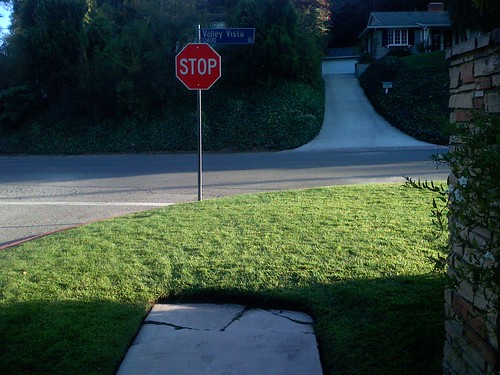
Going for a walk in suburbia can lead to some weird existential dilemmas.
Like most neighborhoods in this area, ours is a "development." Twenty years ago, a house-building outfit purchased a previously undisturbed parcel of land and raised 67 houses. There is one exit provided for cars and pedestrians. Although there are now shopping areas fairly close by, our development is typical in that the houses in it didn't arise organically or incrementally as a by-product of the gradual growth of a town, so much as being called into existence as a potential commodity.
The house-builders did not create sidewalks in this subdivision. Because we are outside of town boundaries, no ordinance required this extra expense, so it didn't happen. It's not a huge problem if one wants to walk within the development. The few winding roads don't have much traffic and offer a pleasant enough 20-minute route, down and back.
Trying to walk beyond the development, however, is another story. Sidewalks appear on the road that runs in front of our exit, but they are prone to end as quickly as they begin.
Encountering the end of a sidewalk is a profoundly odd feeling. A recognized place for walkers is such a mundane concept that we forget the assumptions on which the thing is based: that walking has value, that there are perhaps things worth seeing at a slower pace, that fresh air and public interaction has its benefits. This is a fairly modern outlook. Being a "pedestrian" (with its roots in the Latin ped, for "foot") was historically not a favored status. Those who walked could obviously neither afford horse nor carriage; they were part of the hoi polloi, the common masses, mean and without note. This sense survives in the adjectival meaning of the word in such uses as "pedestrian prose." Meanwhile, the aristocratic class could safely stroll along their own manor garden pathways as a matter of cultured choice.
With the rise of a middle class, democratic in gesture if not in actuality, the notion of a public walkway and its uses may have been rehabilitated. It's difficult to imagine small town life in pre-1970s America without the iconic idea of a public knit together by strolling neighbors, customers, and families...at least within the town's boundaries. Walking travelers, despite the Johnny Appleseed and Huck Finn mythologies, were still not likely to be trusted.
The domination of current car culture, however, and its massive extension into how communities are organized in the form of modern suburbs, has returned many communities to a pedestrian-suspicious stance. This is not helped when there simply aren't places to walk. Or if those places suddenly end.
The end of a sidewalk is an abrupt insight into the agreements we take for granted in living together. Some things (we might agree) are a general "good"--fire stations, sewage treatment plants, libraries, sidewalks. They're worth a small cost from everyone for the sake of the public welfare. In these respects we might find value in some socialistic notions. We are not islands unto ourselves (or at least we aren't in the culture we live in now). Libertarians and conservatives speak of the "tragedy of the commons," but this strikes me as an oversimplification. We might just as easily point to examples of common resources not exploited or ruined by selfish interests, having merit both tangible and intangible.
The end of the sidewalk reveals that the sense of community and public good that "sidewalkness" is based upon is, in this case, a sham. A sidewalk that goes nowhere, that simply ends, loses its function. It becomes revealed as a cynical gesture, something required for one's property (or one's "development") to a certain point but no further. The real meaning, of course, is that this kind of "sidewalk" is not really made for people to actually walk on. Where would they go? Stopping, reversing one's path, stopping, reversing again...the whole thing becomes a travesty, an unintentionally incisive critique of modern living. The floating sidewalk is the victory of form of substance, which is itself an axiom of suburban life. In deconstructionist terms, the "signifier" has overshadowed the "signified."
I'd like to say that the lack of sidewalks hasn't kept me from taking nice long walks, but I'd be lying. It's uncomfortable, awkward, and dangerous to walk the shoulders of these local roads.
This is a shame--there's a lane not far from our house that offers a three-mile route to a local lake. We walked it once, and it was quiet and pleasant. Except when cars appeared around bends at 35 mph and forced us into the mud and weeds.
A sidewalk won't make the traffic go away. But it would probably bring a few more people out on that road to show that it's a place for people as well.
1 comment:
There is a place where the sidewalk ends
And before the street begins,
And there the grass grows soft and white,
And there the sun burns crimson bright,
And there the moon-bird rests from his flight
To cool in the peppermint wind.
Let us leave this place where the smoke blows black
And the dark street winds and bends.
Past the pits where the asphalt flowers grow
We shall walk with a walk that is measured and slow,
And watch where the chalk-white arrows go
To the place where the sidewalk ends.
Yes we'll walk with a walk that is measured and slow,
And we'll go where the chalk-white arrows go,
For the children, they mark, and the children, they know
The place where the sidewalk ends.
Post a Comment